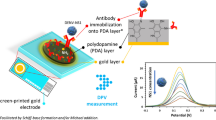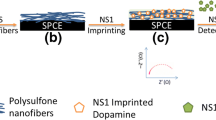Abstract
Dengue is an infectious viral disease transmitted by the Aedes aegypti mosquito, the control of which is complex. In addition, the clinical diagnosis is difficult to perform since it resembles other febrile infections; thus, the development of more effective methods to detect dengue virus (DV) has drawn increasing attention. The present study aimed to develop an impedimetric immunosensor for dengue diagnosis using a screen-printed electrode (SPE) functionalized with polymer films derived from 4-aminophenylacetic acid (4-APA). Data obtained from scanning electron microscopy (SEM) showed the deposition of a uniformly distributed material over the electrode surface. The immunosensor was based on the specific interaction between dengue antigen, NS1 protein, and anti-NS1 antibodies, IgG and IgM. In a characterization study using cyclic voltammetry (CV), the polymer film showed two oxidation peaks at +0.17 and + 0.35 V in 0.50 M sulfuric acid solution, indicating its adsorption and electroactivity at the SPE surface. Electrochemical impedance spectroscopy (EIS) measurements showed a higher charge transfer resistance (Rct) to the polymer film-modified SPE as compared with the bare SPE, corroborating a previous study. The best rNS1 concentration for immobilization was 1.00 ng/mL, and the immunoreaction time between the antigen (Ag) and the antibody (Ab) was 20 min. Dilutions of positive and negative clinical serum samples were evaluated by EIE, from which it was possible to elucidate, for the positive serum, that the more diluted the serum the greater the Rct. Negative serum also showed an analytical signal, probably due to the presence of non-specific antibodies; however, the generated signal presented values closer to the rNS1 signal, indicating good selectivity of the proposed platform. The experiments were repeated using bare SPE to verify the importance of the polymer film in biosensor construction. No significant difference was observed between these results.

Proposed schematic for the genosensor development







Similar content being viewed by others
References
B. Adhikari, S. Majumdar, Polymers in sensor applications. Prog. Polym. Sci. 29, 699–766 (2004). https://doi.org/10.1016/j.progpolymsci.2004.03.002
Agrisera (2018) Molecular weight and isoelectric point of various animal immunoglobulins. 2018 [Cited 2018 07/03/2018]; Available from: http://www.agrisera.com/en/info/molecular-weight-and-isoelectric-point-of-various-immunoglobulins.html
D. Atias, Y. Liebes, V. Chalifa-Caspi, L. Bremand, L. Lobel, R.S. Marks, P. Dussart, Chemiluminescent optical fiber immunosensor for the detection of IgM antibody to dengue virus in humans. Sensors Actuators B Chem 140, 206–215 (2009). https://doi.org/10.1016/j.snb.2009.03.044
Bletchly C (2002) Antigenic and structural analysis of the NS1 glycoprotein of dengue virus. PhD Thesis, University of Queensland
I.T. Cavalcanti, B.V. Silva, N.G. Peres, P. Moura, M.D. Sotomayor, M.I. Guedes, R.F. Dutra, A disposable chitosan-modified carbon fiber electrode for dengue virus envelope protein detection. Talanta 91, 41–46 (2012). https://doi.org/10.1016/j.talanta.2012.01.002
J. Cecchetto, F.C. Carvalho, A. Santos, F.C.B. Fernandes, P.R. Bueno, An impedimetric biosensor to test neat serum for dengue diagnosis. Sensors Actuators B Chem 213, 150–154 (2015). https://doi.org/10.1016/j.snb.2015.02.068
A.C. Dias, S.L. Gomes-Filho, M.M. Silva, R.F. Dutra, A sensor tip based on carbon nanotube-ink printed electrode for the dengue virus NS1 protein. Biosens. Bioelectron. 44, 216–221 (2013). https://doi.org/10.1016/j.bios.2012.12.033
A.K. Falconar, P.R. Young, Production of dimer-specific and dengue virus group cross-reactive mouse monoclonal antibodies to the dengue 2 virus non-structural glycoprotein NS1. J. Gen. Virol 72, 961–965 (1991). https://doi.org/10.1099/0022-1317-72-4-961
M. Flamand, F. Megret, M. Mathieu, J. Lepault, F.A. Rey, V. Deubel, Dengue virus type 1 nonstructural glycoprotein NS1 is secreted from mammalian cells as a soluble hexamer in a glycosylation-dependent fashion. J. Gen. Virol. 73, 6104–6110 (1999)
E.A. Henchal, L.S. Henchal, B.K. Thaisomboonsuk, Topological mapping of unique epitopes on the dengue-2 virus NS1 protein using monoclonal antibodies. J. Gen. Virol. 68, 845–851 (1987). https://doi.org/10.1099/0022-1317-68-3-845
E.A. Hunsperger, S. Yoksan, P. Buchy, V.C. Nguyen, S.D. Sekaran, D.A. Enria, J.L. Pelegrino, S. Vázquez, H. Artsob, M. Drebot, D.J. Gubler, S.B. Halstead, M.G. Guzmán, H.S. Margolis, C.M. Nathanson, N.R. Rizzo Lic, K.E. Bessoff, S. Kliks, R.W. Peeling, Evaluation of commercially available anti–dengue virus immunoglobulin M tests. Emerg. Infect. Dis. 15, 436–440 (2009). https://doi.org/10.3201/eid1503.080923
G.C. Júnior, A.P.S. Silva, L.S. Guinesi, Synthesis, characterization and electropolymerization of a new polypyrrole iron (II) Schiff-base complex. Southeast Asian J. Trop. Med. Public Health 23, 1953–1960 (2004). https://doi.org/10.1016/j.poly.2004.04.029
F.M. Kassim, M.N. Izati, T.A. TgRogayah, Y.M. Apandi, Z. Saat, Use of dengue NS1 antigen for early diagnosis of dengue virus infection. Southeast Asian J Trop Med Public Health 42, 562–569 (2011)
S. Kwakye, A. Baeumner, A microfluidic biosensor based on nucleic acid sequence recognition. Anal. Bioanal. Chem. 376, 1062–1068 (2003). https://doi.org/10.1007/s00216-003-2063-2
I.M. Mackay, Real-time PCR in the microbiology laboratory. Clin. Microbiol. Infect 10, 190–212 (2004). https://doi.org/10.1111/j.1198-743X.2004.00722.x
D.T. McQuade, A.E. Pullen, T.M. Swager, Conjugated polymer-based chemical sensors. Chem. Rev. 100, 2537–2574 (2000). https://doi.org/10.1021/cr9801014
M.M. Silva, A.C. Dias, M.T. Cordeiro, E. Marques Jr., M.O. Goulart, R.F. Dutra, A thiophene-modified screen printed electrode for detection of dengue virus NS1 protein. Talanta 128, 505–510 (2014). https://doi.org/10.1016/j.talanta.2014.06.009
C.P. Simmons, J.J. Farrar, vV. Nguyen, B. Wills, Dengue. N. Engl. J. Med. 366, 1423–1432 (2012). https://doi.org/10.1056/NEJMra1110265
P.D. Sinawang, V. Rai, R.E. Ionescu, R.S. Marks, Electrochemical lateral flow immunosensor for detection and quantification of dengue NS1 protein. Biosens. Bioelectron 77, 400–408 (n.d.). https://doi.org/10.1016/j.bios.2015.09.048
V. Somerset, J. Leanera, R. Mason, E. Iwuoha, A. Morrin, Development and application of a poly(2,2′-dithiodianiline) (PDTDA)-coated screen-printed carbon electrode in inorganic mercury determination. Electrochim. Acta 55, 4240–4246 (2010). https://doi.org/10.1016/j.electacta.2009.01.029
D.F. Tai, C.Y. Lin, T.Z. Wu, J.H. Huang, P.Y. Shu, Artificial receptors in serologic tests for the early diagnosis of dengue virus infection. Clin. Chem. 52, 1486–1491 (2006). https://doi.org/10.1373/clinchem.2005.064501
K.F. Tang, E.E. Ooi, Diagnosis of dengue: An update. Expert Rev. Anti-Infect. Ther. 10, 895–907 (2012). https://doi.org/10.1586/eri.12.76
J. Wang, Portable electrochemical systems. Trends Anal. Chem 21, 226–232 (2002). https://doi.org/10.1016/S0165-9936(02)00402-8
J. Wang, Nanomaterial-based electrochemical biosensors. Analyst 130, 421–426 (2005)
S.M. Wang, S.D. Sekaran, Evaluation of a commercial SD dengue virus NS1 antigen capture enzyme-linked immunosorbent assay kit for early diagnosis of dengue virus infection. J. Clin. Microbiol. 48, 2793–2797 (2010). https://doi.org/10.1128/JCM.02142-09
W.R. Wong, O. Krupin, S.D. Sekaran, F.R. Mahamd Adikan, P. Berini, Serological diagnosis of dengue infection in blood plasma using long-range surface plasmon waveguides. Anal. Chem. 86, 1735–1743 (2014). https://doi.org/10.1021/ac403539k
World Health Organization (2012) Global strategy for dengue prevention and control 2012-2020. WHO report http://www.who.int/denguecontrol/9789241504034/en. Accessed 30 March 2018
World Health Organization (2017) Dengue and severe dengue. WHO http://www.who.int/mediacentre/factsheets/fs117/en. Accessed 30 March 2018
T.Z. Wu, C.C. Su, L.K. Chen, H.H. Yang, D.F. Tai, K.C. Peng, Piezoelectric immunochip for the detection of dengue fever in viremia phase. Biosens. Bioelectron. 21, 689–695 (2005). https://doi.org/10.1016/j.bios.2004.12.019
N.V. Zaytseva, R.A. Montagna, A.J. Baeumner, Microfluidic biosensor for the serotype-specific detection of dengue virus RNA. Anal. Chem. 77, 7520–7527 (2005). https://doi.org/10.1021/ac0509206
Acknowledgements
The authors are grateful for financial support from Conselho Nacional de Desenvolvimento Científico e Tecnológico (CNPq) (Process: 458996/2014-9). The authors wish to thank the LMMA, sponsored by FAPEMIG (CEX-112-10) and SECTES/MG, for their support. This work is a collaborative research project with the members of the Rede Mineira de Química (RQ-MG), supported by FAPEMIG (Project: CEX - RED-00010-14).
Author information
Authors and Affiliations
Corresponding author
Rights and permissions
About this article
Cite this article
Pimenta, T.C., Santos, C.d., Thomasini, R.L. et al. Impedimetric immunosensor for dengue diagnosis using graphite screen-printed electrodes coated with poly(4-aminophenylacetic acid). Biomed Microdevices 20, 78 (2018). https://doi.org/10.1007/s10544-018-0324-2
Published:
DOI: https://doi.org/10.1007/s10544-018-0324-2




